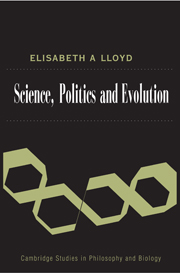Book contents
- Frontmatter
- Contents
- 1 The Nature of Darwin's Support for the Theory of Natural Selection
- 2 A Semantic Approach to the Structure of Population Genetics
- 3 Confirmation of Ecological and Evolutionary Models
- 4 Units and Levels of Selection
- 5 Species Selections on Variability
- 6 An Open Letter to Elliott Sober and David Sloan Wilson, Regarding Their Book, Unto Others: The Evolution and Psychology of Unselfish Behavior
- 7 Problems with Pluralism
- 8 Normality and Variation: The Human Genome Project and the Ideal Human Type
- 9 Evolutionary Psychology: The Burdens of Proof
- 10 Objectivity and the Double Standard for Feminist Epistemologies
- 11 Science and Anti-Science: Objectivity and Its Real Enemies
- 12 Pre-Theoretical Assumptions in Evolutionary Explanations of Female Sexuality
- References
- Index
2 - A Semantic Approach to the Structure of Population Genetics
Published online by Cambridge University Press: 27 February 2010
- Frontmatter
- Contents
- 1 The Nature of Darwin's Support for the Theory of Natural Selection
- 2 A Semantic Approach to the Structure of Population Genetics
- 3 Confirmation of Ecological and Evolutionary Models
- 4 Units and Levels of Selection
- 5 Species Selections on Variability
- 6 An Open Letter to Elliott Sober and David Sloan Wilson, Regarding Their Book, Unto Others: The Evolution and Psychology of Unselfish Behavior
- 7 Problems with Pluralism
- 8 Normality and Variation: The Human Genome Project and the Ideal Human Type
- 9 Evolutionary Psychology: The Burdens of Proof
- 10 Objectivity and the Double Standard for Feminist Epistemologies
- 11 Science and Anti-Science: Objectivity and Its Real Enemies
- 12 Pre-Theoretical Assumptions in Evolutionary Explanations of Female Sexuality
- References
- Index
Summary
INTRODUCTION
Known to be unlike Newtonian mechanics but also unlike Creationist biology, modern evolutionary theory has a structure that has proved difficult to characterize. Recently, John Beatty (1980, 1981, 1982) and Paul Thompson (1983) have approached the problem of describing the structure of evolutionary theory using the semantic approach developed by P. Suppes, B. C. van Fraassen, and F. Suppe.
Advantages of the semantic view over the logical positivist approaches that, until recently, dominated discussions of theory structure, have been presented by Suppes (1957, 1961, 1962, 1967), van Fraassen (1970, 1972, 1974, 1980), Suppe (1972, 1973, 1974, 1977), and Stegmuller (1976), and will not be discussed here.
The semantic approach, in which I include both the “set theoretic” and “state space” approaches, has been used to describe the structure of Newtonian mechanics, equilibrium thermodynamics, quantum mechanics, and parts of biological theory (Sneed 1971; Stegmuller 1976; Suppes 1957; Wessels 1976; Moulines 1975; van Fraassen 1970, 1972, 1974; Suppe 1974a; see Suppe 1974, 1979 for a summary of the semantic view and its literature).
I shall assume the following positions in this paper, without defense: the semantic view – in particular, the state space version – is more suited to a description of evolutionary theory than any axiomatic view (Beatty 1980, 1981, 1982; Thompson 1983); the semantic view can provide a richer and more useful description of the structure of a theory than axiomatic approaches (see especially Suppe 1972; van Fraassen 1980); and, finally, the semantic view is capable of formally describing theories that are not describable using any axiomatic approach (van Fraassen 1986).
- Type
- Chapter
- Information
- Science, Politics, and Evolution , pp. 20 - 42Publisher: Cambridge University PressPrint publication year: 2008

